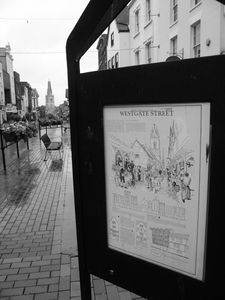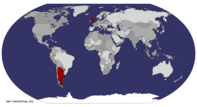Advertisement
Published: August 6th 2007

 Westgate Street
Westgate Street
(That's not the Cathedral at the end - that's another church.)Tailoring Mice and Trolls in the Lavatory in Gloucester
On Saturday I hopped on the top level of a double-decker bus (I sat in the very front, of course) and went to Gloucester (pronounced "Gloster"), a town about 30 minutes away. This link will show you a map:
Map. The weather forecast had predicted torrential downpours all day, but since it just seemed to be drizzling, I went ahead and risked it. It's rained every day since I've been here, but it's never been the kind of rain that will soak you through and through. It's just a steady drizzle that makes everything damp and uncomfortable.
The bus dropped me in the middle of a market in Gloucester. Besides the usual fruits and vegetables, there were also stalls selling cell phones, video games, women's underwear... I swear I thought I was back in Russia.
My ultimate goal for the day was the Gloucester Cathedral. It being the tallest thing around, I didn't bother to ask directions. However, as I went through some narrow alleyways, I could no longer see the steeple. I ended up on a main shopping thoroughfare that was pedestrian only called Westgate Street. This used
to be the center of trade in Gloucester, where Alfred the Great set up a mint in 872 AD. In the 16th century, the cheese and butter traders set up shop here, hawking the famous Single and Double Gloucester cheeses. (I haven't tried them yet, but I will...)
Spotting the Cathedral once again, I ducked down a brightly colored alley that was full of flags and hanging fuschia plants as a shortcut, and I'm so glad I did. Just before the end, I saw a little shop that looked ancient, full of Beatrix Potter souvenirs. I went in out of the drizzle. When I looked around, it seemed like it was mostly commercial shop, but there were museum aspects to it. I turned to the expectant little old British ladies running the place and said, "Um, I have a silly question. What is this place?"
They got really excited and told me all about it. One of Beatrix Potter's early books is called The Tailor of Gloucester. It's based on a true story of a real tailor of Gloucester, whose shop used to be where the Union Pub is now (see picture below). The tailor was behind in
his work and was due to complete an elegant wedding outfit for the mayor of Gloucester for his wedding. One night, the tailor's assistants had too much to drink and went to take shelter in the shop, for which they had a key, unbeknownst to the tailor. To pass the time, they finished all the detailed embroidery on the waistcoat and left a note saying it had been completed by the fairies. The tailor, of course, knew who had actually done the work, but he started using it as an ad campaign - "Have your tailoring done by fairies with stitches too tiny for human hands." Beatrix Potter heard this story and thought it was delightful - but she changed the fairies into mice. She also thought the real tailor's shop was too prosperous, so she drew this little house, instead. And if you look in the book, you'll see the drawings match the pictures I took. I made sure to buy a copy of the book with a little sticker saying where I had purchased it.
On to the Cathedral. An abbey dedicated to St. Peter was founded on this site in 681. They started building the current

 The Real Tailor of Gloucester shop
The Real Tailor of Gloucester shop
Look at page 37 of The Tailor of Glocester by Beatrix PotterCathedral in 1089, almost 1000 years ago. At that time, of course, the church was Catholic. However, in 1540, Henry VIII abolished all the monasteries and turned the country Protestant because the Pope wouldn't give him a divorce. Abolishing the monasteries also had this handy little side benefit of transferring all their vast wealth and holdings to the crown. The abbey in Gloucester, however, was spared. This is because a relative of Henry's, Kind Edward II, was buried here. Thus it became Gloucester Cathedral and was spared to this day.
The Cathedral was absolutely stunning. I particularly loved the roof and all the carved stonework. The biggest stained glass window in the Great East Window, which is about the size of a tennis court and was created around 1350. It has had some repairs over the years, but they say about 75% of the glass is original. It was the largest and grandest window in England at the time it was created.
I went on a tour of the crypt below the choir and altar areas. I was all excited to see more tombs... but alas, nothing spooky at all, unless you count the room where all the

 The Union Pub
The Union Pub
Original location of the shop of the real tailor of Gloucesterrecently deceased monks were laid out and chanted over before being buried. The guide made sure to talk about how many monks lived here, basically waiting for their turn to come through this room. The monks would often come in around age 8. Then, since the monasteries were very wealthy, monks often weighed twice as much and lived twice as long as the average citizen, so they may last until 80. His body would be laid out in this tiny underground room, and all the 100 or so monks would cram in and chant all night. This lasted for hundreds of years, for thousands of monks... the guide tried to imply that their spirits hanging around. This prompted the little boy behind me to turn around, look up at his father, and ask, "Can we go now?"
Next I went up to the gallery and took a closer look at the Great East window. Behind the window was a curved gallery that you could walk through. It is known as the whispering gallery, because two people standing at opposite ends can whisper to each other and be heard, even though the distance between them is huge. See the picture

 Simpkin searching the cupboards
Simpkin searching the cupboards
Look at page 21 of The Tailor of Gloucester by Beatrix Potterbelow to see the nice British lady who whispered to me - and just how far away she really was.
After that, I went to the Cloisters where the monks used to live. The stonework was amazing. If all of this looks vaguely familiar, that's because parts of the first two Harry Potter movies were filmed here. That's right - you've arrived at Hogwarts. To its credit, the Cathedral staff didn't mention it once, so I only realized this after I got home. These Cloisters walks were used as hallways in Hogwarts, the entrance to Gryffindor tower, the entrance to Myrtle's bathroom in the second film, and the scene with the big giant troll in the lavatory in the first film. I took a picture of the lavatory, because I thought it was interesting to see this long trough where the monks washed up before meals. However, there was one little girl insisting rather loudly to her mother that it was a toilet. Anyway, I just now found an article about the filming of the movie at the Cathedral - you can read it here.
After all this wandering around, I was getting hungry... so I had a
Cornish pastie (pronounced "pass-tee") on a bench on Westgate Street. Pasties are sort of like calzones, but instead of tomato sauce and cheese, they're filled with meat and potatoes. They are incredible. I had one that was ham, leeks, cheese, and potato... ahhh...
Afterwards, I did a little shopping, mainly in a rambling used bookstore, where I purchased several hardback books which I then had to lug around. I don't think I'll ever learn. However, they were true treasures - I got four books on knitting with a knitting machine. Since I dug two knitting machines out of Nana's attic over Christmas and have been unable to find any books at the library or on the internet on how to use the durn things, these books were like gold to me. Not to anyone else, I'm sure, but definitely to me.
Afterwards, I went down to the Gloucester city docks. This was on the advice of a Gloucester man who shared a bench with me as I ate my pastie. He said that they used to get lots of big ships up the Severn River from the Atlantic (see? I travel all this way and end up in

 Gloucester Cathedral Nave
Gloucester Cathedral Nave
This shows the nave up to the organ, which is located where there used to be a screen separating the people from the choir area and altar.Severn!), but the docks area has been "restored" in the past few years, with a lot of the warehouses being turned into "posh flats" and snooty shops. Now the ships can't fit. He said lots of Gloucester natives were upset about it. So I lugged my books down there to have a look-see... and didn't really see anything worth looking at. Oh well. I hauled myself back to the bus and went home.
So there you have it. Potter mania in Gloucester. Make sure you look at all the pictures - I think I threw so many on this page that they've shifted some to the next page. Just follow the links.
And I take back what I said about rain only drizzling - it's pouring outside now. Sigh...
Advertisement
Tot: 0.065s; Tpl: 0.014s; cc: 8; qc: 26; dbt: 0.031s; 1; m:domysql w:travelblog (10.17.0.13); sld: 1;
; mem: 1.1mb
























roddy
non-member comment
seems like a great day out
yor blog has inspired me to visit gloucester even when it is raining it looks like a good place to go good photos too.